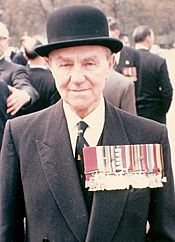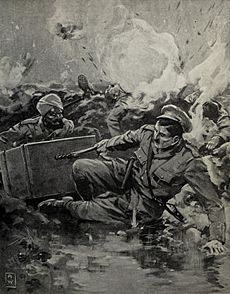Sir John Smyth, 1st Baronet facts for kids
Quick facts for kids
Sir John Smyth
|
|
|---|---|

Sir John Smyth VC, pictured here circa 1973.
|
|
| Member of Parliament for Norwood |
|
| In office 23 February 1950 – 10 March 1966 |
|
| Preceded by | Ronald Arthur Chamberlain |
| Succeeded by | John Fraser |
| Personal details | |
| Born |
John George Smyth
24 October 1893 Teignmouth, Devon, England |
| Died | 26 April 1983 (aged 89) Marylebone, London, England |
| Resting place | Golders Green Cemetery |
| Political party | Conservative |
| Alma mater | Royal Military College, Sandhurst |
| Nickname | "Jackie" |
| Military career | |
| Allegiance | United Kingdom British India |
| Service/ |
British Army British Indian Army |
| Years of service | 1912–1942 |
| Rank | Brigadier |
| Service number | 49726 |
| Unit | 15th Ludhiana Sikhs 11th Sikh Regiment |
| Commands held | 17th Indian Infantry Division 19th Indian Infantry Division 36th Indian Infantry Brigade 127th Infantry Brigade |
| Battles/wars |
|
| Awards |
|
| Other work | Privy councillor Member of Parliament |
Sir John George Smyth, often called Jackie Smyth, was a brave British soldier and a politician. He was born on October 24, 1893, and passed away on April 26, 1983. He served in the British Indian Army and later became a Member of Parliament for the Conservative Party.
Sir John was awarded the Victoria Cross (VC), the highest award for bravery in the British military. He also received the Military Cross (MC) for his courage. Even though he was a hero, his military career ended with some disagreement.
Contents
Early Life and School Days
John Smyth was born in 1893 in Teignmouth, a town in Devon, England. His father, William John Smyth, worked for the Indian Civil Service.
John went to school at Dragon School and Repton School. After that, he studied at the Royal Military College, Sandhurst. This is a famous place where people train to become army officers.
A Brave Military Career
After finishing his training at Sandhurst, John Smyth joined the British Indian Army in 1912. He became a second lieutenant and then a lieutenant in the 15th Ludhiana Sikhs regiment.
Heroism in World War I
When the First World War started, John Smyth was 21 years old. He showed incredible bravery on May 18, 1915, near a place called Richebourg L'Avoue. He led a small group of 10 soldiers to deliver bombs to the enemy's position. This was a very dangerous task, and two other groups had already failed.
John Smyth managed to get the bombs to where they needed to be, even though eight of his men were killed or hurt. He even had to swim across a stream while being shot at by cannons, machine guns, and rifles. For this amazing act of courage, he was awarded the Victoria Cross in June 1915. The men who died during this brave mission also received a special medal called the Indian Distinguished Service Medal.
He also received a Russian award, the Order of St. George, and was promoted to captain in 1916. He continued to serve in places like Egypt and the North-West Frontier.
Between the Big Wars
In 1920, John Smyth received another award, the Military Cross (MC). This was for his excellent service in Waziristan. He showed great leadership and quick thinking, which helped prevent a serious disaster and saved a valuable convoy that was under attack.
In 1923, while serving in India, Smyth also played two first-class cricket matches.
He returned to England and attended the Staff College, Camberley from 1923 to 1924. Many of his classmates later became important military leaders. He was promoted to major in 1928 and then to lieutenant colonel in 1933. His career was moving very quickly!
Serving in World War II
Before World War II began, Smyth asked a top general, Lord Gort, for a command in the United Kingdom if war broke out. He got his wish and was put in charge of the 127th (Manchester) Brigade in February 1940. He led this brigade in France as part of the British Expeditionary Force (BEF).
After the troops were evacuated from Dunkirk, he continued to command his brigade in Britain. In 1941, he was sent back to India and later took command of the 17th Indian Infantry Division.
The Sittang River Controversy
In February 1942, during the Burma campaign, there was a big problem with the 17th Indian Division. They were retreating across the Sittang River. It was said that Smyth did not make sure enough soldiers were on the other side of the river before the bridge was blown up. This meant many soldiers were trapped and could not cross, leading to a big loss for the British forces.
Because of this, the Commander-in-Chief, Sir Archibald Wavell, was very angry and removed Smyth from his command. Smyth believed he had warned his corps commander, General Hutton, about the danger earlier, but his advice was not taken. He later wrote a book called Milestones to share his side of the story.
After this, Smyth did not receive any more military commands and retired from the army.
Life After the Army
After his military career, Sir John Smyth entered politics. He became a Member of Parliament for Norwood in 1950. He was made a baronet in 1956, which is a special title, and a privy counsellor in 1962. He retired from Parliament in 1966. He was the last person to have won the Victoria Cross and also serve in the British Parliament.
Sir John was also a talented writer, a playwright, a journalist, and a broadcaster. He loved cats and even wrote three books about them: Beloved Cats, Blue Magnolia, and Ming: The Story of a Cat Family.
He was married twice and had four children. Sadly, one of his sons, Captain John Lawrence Smyth, was killed in action during the Battle of Kohima in 1944.
Sir John Smyth's Victoria Cross medal is now on display at the Imperial War Museum in London.
Images for kids



